In early April, Jen Laskey of NBC News encapsulated something many of us noticed during lockdown in her article Knocking back too many ‘quarantinis’ : “It’s not just hand sanitizer and toilet paper that have been flying off the shelves — alcohol has been selling like crazy too.”
At our house, the beer cans seemed to pile up higher than usual this spring. I gather this wasn’t uncommon for the suddenly isolated. As Laskey notes, “Under normal circumstances…most adults who drink are able to do so within responsible limits. But studies show that catastrophic events can trigger increased substance use.” Of five recommendations she provided to combat overdrinking, one was to consider low- or no-alcohol beverages.
Back in the 1990s, this author occasionally bought supermarket “near beers” in an attempt to enjoy a cold one sans tipsiness. As is still the case with generic non-alcoholic brews, it was clear I wasn’t drinking a real beer, rendering enjoyment elusive.
A quarter century has passed. Has the development of technology made it possible to make a brew that is sufficiently close to the real thing that a beer enthusiast will look forward to drinking it?
The search for a nearer “near beer”
It’s said that the reason breweries can’t produce a great non-alcoholic beer is that the methods used tend to destroy the appeal of the product. Either you arrest the fermentation before it can create an abundance of alcohol—and a commensurate measure of flavour—or you heat the beer to drive off the ethyl alcohol. Brew Your Own magazine notes, “if your beer had any hop flavor or aroma before the heating took place, then these flavors and aromas will most likely be driven off.” Vacuum distilling lowers the alcohol’s boiling point to minimize this impact, but it normally still requires some level of heat.
If those options aren’t appealing, there’s always that other approach to reduce alcohol in your finished brew: just water it down.
Central City Brewers & Distillers of Surrey has an alternative that avoids diluting or “cooking” the beer. It is the first craft brewery in Canada to employ the Cadillac of methods: reverse osmosis.
Why the premium-sounding reference? Because of the expense. Beer Cartel’s review of non-alcoholic beers, a breakdown the three main approaches to dealcoholization, summarizes that:
Reverse osmosis allows any type of beer to become alcohol-free and, since the main ingredients are not heated to oblivion, the beer’s flavour is much less affected. This method however remains fairly impractical; it’s more labour intensive and requires more equipment – both of which mean higher costs.
Central City made their name by bringing a new level of hoppiness to BC beer fans back in the mid to late 2000s with Red Racer IPA. It makes sense for a brand synonymous with hops to bring a premium dealcoholized IPA to market, and their Street Legal series debuted last year. And it cost them a pretty penny to get into the game—$1.5 million for the system.
So far, the product is making inroads in the local market, and the investment may pay off. The uptake has been sufficient that the brewery is expanding production.
Central City didn’t set out to become a competitive non-alcoholic beer producer. In fact, their brewmaster had no interest in the subject until it came up more or less by accident.
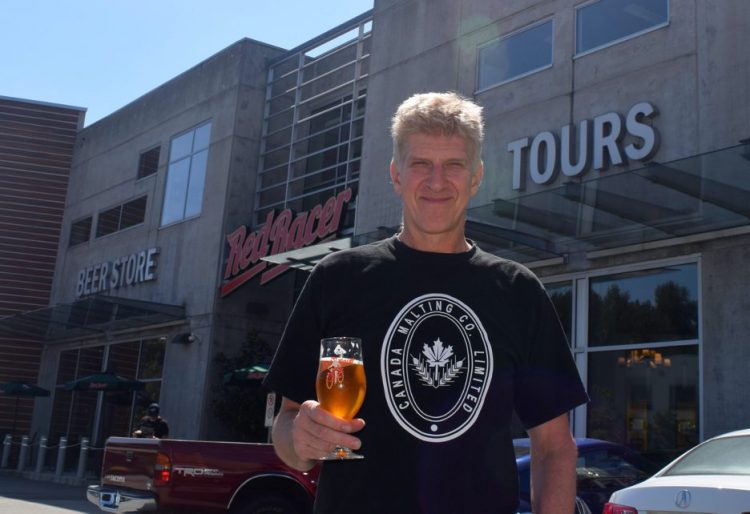
Brewmaster Gary Lohin with a Street Legal IPA at Central City’s Bridgeview plant: not a small brewpub anymore
THC beer plans go up in smoke
Gary Lohin is founding head brewer at Central City, which opened its original Surrey Central doors in 2003. Having won countless awards including multiple national honours, he’s been regarded as one of Canada’s foremost craft brewers. He’s also known for pushing boundaries, not only in use of hops but in industrial techniques.
A couple of years ago, Canada was preparing to legalize cannabis and Central City was investigating the potential market for THC beers. CCB was in talks with a Colorado-based group and learning about the technology involved. Because it would be illegal to sell a product with both alcohol and THC, the first requirement was to create a non-alcoholic beer base. Although the market for THC beers didn’t develop as predicted, Central City’s research phase gave them a better understanding of the processes available for dealcoholization—and a taste of what was possible.
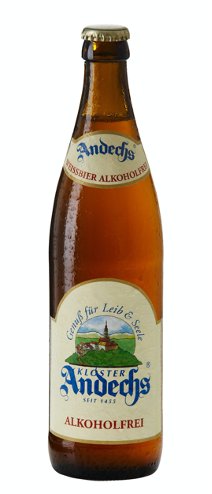 GEA Group AG of Düsseldorf, Germany is a global technology supplier for the food processing industry. One of their divisions fabricates brewhouses (the shiny beer-making stuff in the back of a brewery), including a kit marketed to craft breweries. Their AromaPlus Membrane Dealcoholization Unit caught the attention of Lohin and group when they sampled a product that had passed through GEA’s reverse osmosis system.
GEA Group AG of Düsseldorf, Germany is a global technology supplier for the food processing industry. One of their divisions fabricates brewhouses (the shiny beer-making stuff in the back of a brewery), including a kit marketed to craft breweries. Their AromaPlus Membrane Dealcoholization Unit caught the attention of Lohin and group when they sampled a product that had passed through GEA’s reverse osmosis system.
“GEA gave us a sample from Klosterbrauerei Andechs, a monastery brewery in Bavaria,” Gary recalls. “They made a dealcoholized Hefeweizen. We tasted it and I was blown away. If somebody gave you that, you would not know that that was a dealcoholized product.”
“GEA had just put together a test dealcoholization plant in Madison, Wisconsin,” Lohin continues. “We had arranged to have some of our IPA sent down. We did our regular IPA and our Super Solar, and it came out amazing. That was really the catalyst: the quality of the product on first pass-through, without even tweaking the recipe yet.”
As noted, GEA’s system is not within reach of your average small brewery. Central City was first in Canada to adopt it. A year later, a Quebec brewery is becoming the second, making a small handful in North America. For this reason, the German company had Gary booked to present at the US Brewers Association’s Craft Brewers Conference & World Beer Cup in San Antonio, Texas, until COVID-19 killed that April event.
But with the popularity of low- and non-alcoholic beers growing rapidly over the last two years, interest will pick up. “I’ve been fielding calls from all over the place, because we’re one of the first to truly run it with volume in mind,” Lohin confides, acknowledging that they are ready to invest more themselves. “Right now, we have two giant 20-foot-long membranes; we’re going to add three more, for a total of five.”
Lohin’s a big fan of the quality of Street Legal and is fond of fooling his brewer friends by pouring them a glass without telling them it’s dealcoholized. When it began pouring at CCB’s Beatty Street taphouse, he handed me a sample and insisted that the average drinker would never notice the difference between a regular pilsner and the Street Legal version.
I was skeptical but, remembering Gary’s enthusiasm for the brew, I eventually gave it an honest try at home.
The Taste Test
Back in January, my wife and I reviewed Street Legal IPA for What’s Brewing’s sister website, Beer Me BC. At that point, we noted that ‘dry January’ had become a popular annual tradition, and that cutting back on alcohol is not uncommon early in the year. Little did we know that within a couple of months, pandemic-induced isolation would bring alcohol consumption into focus in a completely novel way.
Our first impression was “a decent head…a fairly pungent hop aroma, with a smelly, fruity funk. On the palate, it of course had less body than a regular craft ale in this style, but it wasn’t nearly as thin as the supermarket variety non-alcoholic lagers. It was actually fairly satisfying, giving the initial sensation of drinking a ‘real’ beer.”
We noted that one of our friends who was off alcohol but likes her hops had been drinking Street Legal IPA regularly. Overall, we assessed the beer a score of 3.5 / 5, which is amazing for its category; we would give O’Douls only one to two points. The flavour can’t compete with a full-on, well-made West Coast IPA, but we can candidly say that we’ve occasionally had less impressive-tasting IPAs from craft breweries making them the normal way.
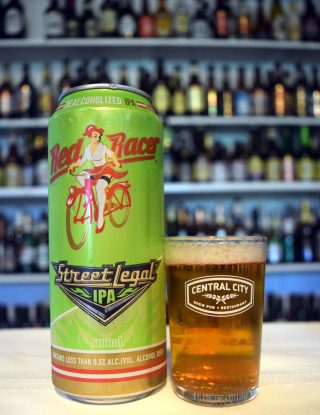 Looking around, it’s not hard to find others taking note of the hoppy brew. BeerCrank says, “So far, this beer looks and smells like something I’d actually expect from Central City’s Red Racer brand.” The Tomato’s craft near beer roundup states, “Simply put, this is an outstanding non-alcoholic beer, coming the closest I found to matching the full flavour and mouthfeel of an alcoholic beer, such as Red Racer’s iconic IPA.”
Looking around, it’s not hard to find others taking note of the hoppy brew. BeerCrank says, “So far, this beer looks and smells like something I’d actually expect from Central City’s Red Racer brand.” The Tomato’s craft near beer roundup states, “Simply put, this is an outstanding non-alcoholic beer, coming the closest I found to matching the full flavour and mouthfeel of an alcoholic beer, such as Red Racer’s iconic IPA.”
I find that the beer has body, which I prefer. I sometimes let it warm up out of the fridge to bring out more flavour, just like one might with any other decent ale. Don’t try that with a Budweiser Prohibition.
To cut down on alcohol, I started having Street Legal as my first beer of the evening, and found it gave me that same “I needed a beer” satisfaction as a regular beer. It made me wonder whether alcohol has anything to do with the sensation a beer drinker craves, of taking the night’s first sip.
Gary notes its value in “cooling off” toward the end of a drinking session without being a buzz-kill. “If you want to hang out with your buddies and keep drinking, and you have to drive in an hour or two, just put these back instead,” he advises. “If you went from, let’s say a (regular) IPA to an O’Doul’s, that’s quite the chasm. But if you’re going to our IPA, it’s not. It’s still super hoppy and tasty.”
I often drink Street Legal up front because it’s not actually realistic to down a dry-hopped double IPA or barrel-aged stout then expect a Street Legal to make a great follow-up. All experienced craft beer drinkers understand this basic rule about sequencing. Lohin’s comments are applicable when you’re drinking something that makes for a good pathway back to a Pilsner or IPA (or you take a serious palate-cleansing break after that barrel-aged stout). For reasons like this, I’m still holding out hope for a satisfying dealcoholized stout or porter. Gary doesn’t seem to rule it out.
“Everybody’s got a lager out there,” he says with regard to non-alcoholic options. “Nobody’s really doing IPAs. We’d like to move to a stout or whatever; really, we can do any beer. Once we optimize and get a bit bigger and quicker, we will be able to do more offerings.”
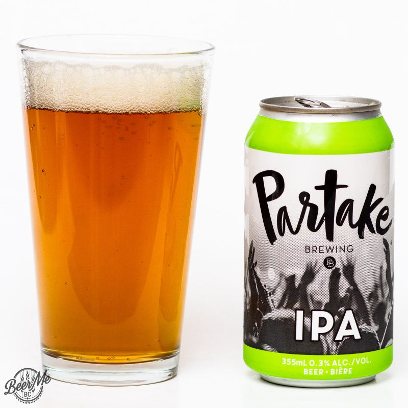 Partake Brewing is another successful Canadian craft-focussed non-alcoholic brand with an IPA. There’s a great writeup on The Tomato detailing its origins. Their product has also been reviewed on Beer Me BC, scoring a very respectable 3.2 / 5 in 2017. Partake IPA comes in at 26 IBU, compared to Red Racer’s 40 IBU.
Partake Brewing is another successful Canadian craft-focussed non-alcoholic brand with an IPA. There’s a great writeup on The Tomato detailing its origins. Their product has also been reviewed on Beer Me BC, scoring a very respectable 3.2 / 5 in 2017. Partake IPA comes in at 26 IBU, compared to Red Racer’s 40 IBU.
Since it was previously brewed in BC at Vancouver’s former Factory Brewing, Partake clearly doesn’t use reverse osmosis. The review reveals the differences the processes make: “The hop character comes through in a pleasant, lightly bitter, piney way. The body is quite thin though and the flavour lacks malt character.” The potential upside of this is that Partake happens to also be a low-calorie beverage. However, that’s not necessarily an advantage for those like me who want body and mouthfeel to their beer, with just the alcohol removed. It may turn out that calories are the secret ingredient needed to make a satisfying experience for some of us.
As I write this, I’m drinking Street Legal. I’m sober, with none of the “fogginess” I would normally associate with throwing back a couple of 500-ml brews. Physically, I feel like I drank a couple of beers. But I’m still productive; if I drank these at a lunch meetup, the rest of my day wouldn’t be toast.
I asked Gary how literally the “Street Legal” name could be taken—can you actually drive with one of these open in your car? Lohin stopped short of recommending that. “I don’t know if it’s legal,” he admits. “But it should be!”
With the gradual adoption of public outdoor drinking in North American society, we’ll see if that day ever comes. In the meantime, maybe they’re not for every occasion, but it’s clear that for more and more people, more and more often, craft quality near beers are a practical option.
More about Street Legal dealcoholized beers on Central City Brewing site →



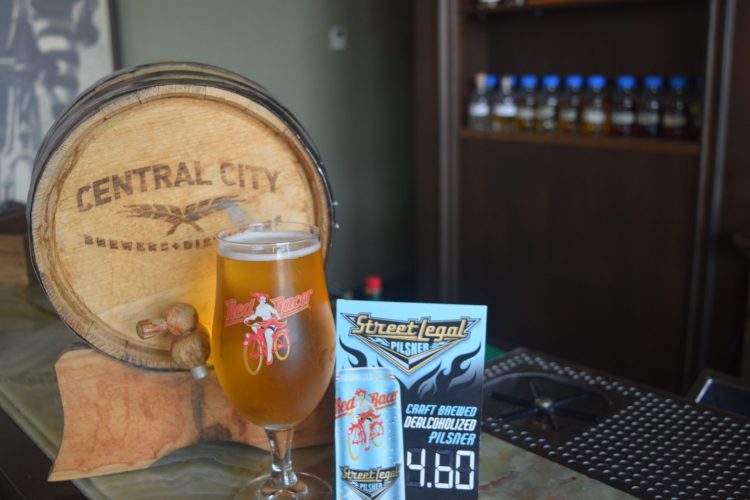
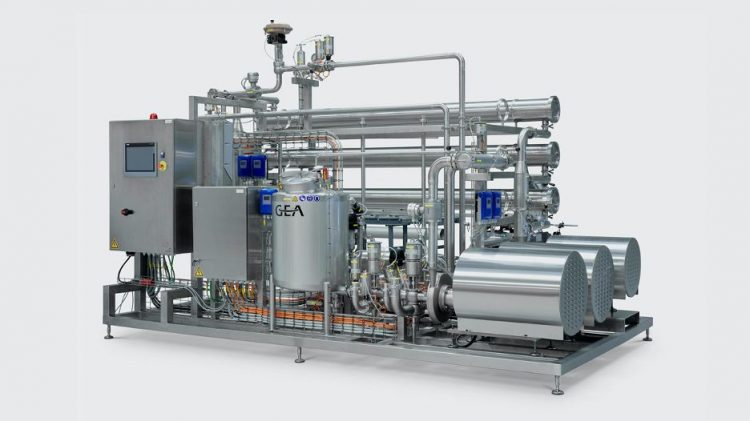


I lived in Toronto in the late 80’s and early 90’s , Upper Canada Brewings non alc ,named Point Nine , I believe was created via a yeast that only produced only 0.9% alcohol but all the carbonation.
It was very good. Had a nice body to it. My roommate and I lived close by and bought kegs of their other beers for home consumption. We were able to try a test batch of this low alc one time. It had a real bad nose to it . When they finally put it to market,
that bad nose had been resolved.